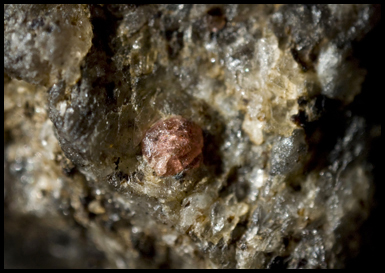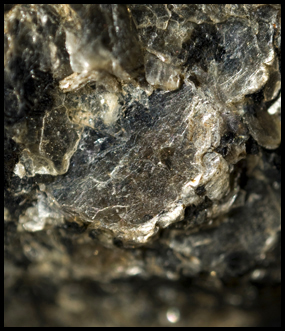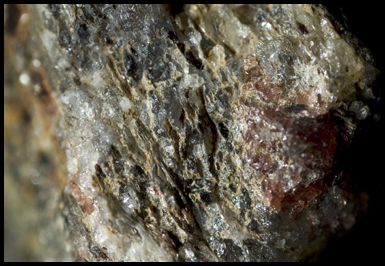An Examination of Mica Schist
Introduction
The purpose of this page is to highlight and describe some of the features of a particular rock I found in my school yard several years ago, which I recently learned is called 'mica schist'. It was found in Brooklyn, New York, and because of the location where it was found, it is most likely Manhattan schist, which is
one of the oldest of the bedrocks found in NYC. It may have ended up in my school yard when materials were being transported for construction. I found this to be an interesting subject to research because I had it for many years and wanted to know more about it. Seen below is an overview of the specimen, showing different sides. It was taken with a 60mm macro lens at 1:1 and is approximately 3cm long.
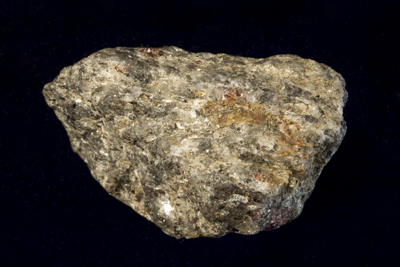
A schist is defined as “a metamorphic crystalline rock that has a closely foliated structure and can be split along approximately parallel planes.” In layman terms, this means it is made up of many layers and if this rock is struck it will break along a particular cleavage; thus the word schist is derived from the Greek word meaning ‘to split’. Manhattan schist, otherwise known as Cambrian Manhattan Formation, is the second oldest of the five bedrock layers in NYC and is found mostly in upper and lower Manhattan. The oldest is Fordham gneiss found in the Bronx, and the other three bedrocks are Hartland formation in Brooklyn, Queens, the Bronx, and Manhattan; Staten Island serpentinite in Staten Island; and Inwood marble in all of Manhattan and beneath the Hudson and East Rivers.
This schist was formed about 450 million years ago when shale was pushed from the ocean floor into the Earth’s molten core during a collision between North America and the Atlantic Ocean. While there, it was transformed by heat and pressure into various minerals including quartz, feldspar, hornblende, and mica. The heat and pressure is what created the metamorphic rock known as schist, and this particular variation contains mica. It is also sedimentary because it is composed of various layers.
Mica itself has many uses in the commercial world, such as electrical insulation, in rockets, and in other environments that require high temperatures. The mica schist bedrock also plays an important role in where the skyscrapers of Manhattan are constructed. The ground is more stable where the schist is closer to the surface, which explains why the taller buildings are more densely clustered in the Midtown area.
Many times, either during or after its creation, extraneous materials can become embedded in a rock. Here is what could possibly be quartz crystal containing iron oxides which give it a reddish colour; it could also be garnet because many times it is found within mica schist. These crystal formations are called porphyroblasts and commonly develop within schists and gneisses. They are generally no more than a few millimeters or centimeters across, but measurements as large as 30cm have been recorded. Below, the first is about 1mm in diameter and the second is about 2mm.
The individual flakes of mica within the schist are visible to the naked eye. They are the reason for the rock’s sparkling and reflective surface. These bits of mica can also be easily flaked off the rock. One major issue with making this image was diffraction. Because of its reflective surface and many different angles, it was necessary to arrange the lights in such a way as to avoid this problem.
Visible here in a diagonal arrangement are a few of the many layers that make up this specimen as a sedimentary rock. These layers under high heat and pressure were compressed and metamorphosed into a single solid rock.
Other materials like mud or clay or any other mineral that may have accumulated over time as sediments can also be found within the layers.
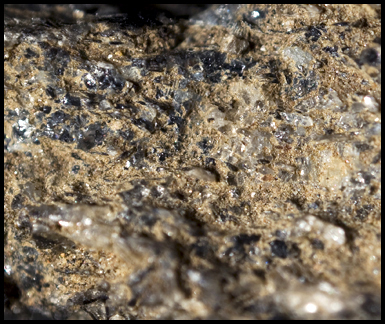
Equipment: Nikon D70, Copy stand, Lab jack, Black cloth, fiber optic lights, 38mm thimble lens, bellows.
The set-up used to create these images was fairly simple. The camera was mounted on a copy stand and the object placed below it. Instead of using what we know as regular macro lenses I instead used thimble lenses attached to bellows, except for the overview images, for which I used a 60mm macro lens. For the detail images I used a 38mm thimble lens, and increased the length of the bellows when more magnification was required.
I tried using tensor lights and axial lighting, but found that the results from fiber optic lights were more favorable. Since these lights are small they were able to create enough contrast and do a better job at showing the texture of the schist.
I used Nikon Capture Control which allows the user to tether the camera to the computer and shoot without actually touching the camera; this allows for less vibration from contact with the camera.
With this particular rock diffraction was almost always present because of its natural reflectiveness and different levels and angles from which the light would reflect. I tried to use water to reduce the diffraction but in this case the best solution was just to change the angle of the light or of the
rock itself.
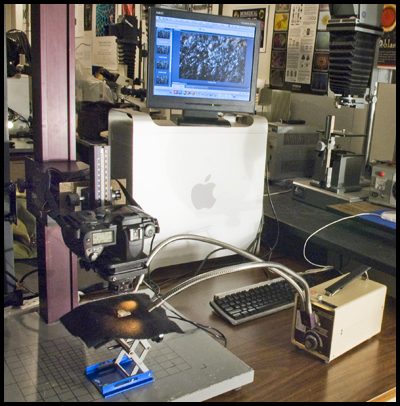
Images
Sources
About the set-up
Background
by Andrea Samuels
Contact
Any questions or comments? Send an email!


